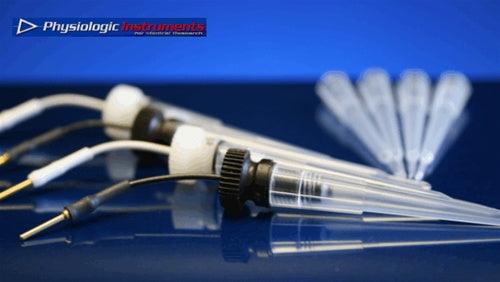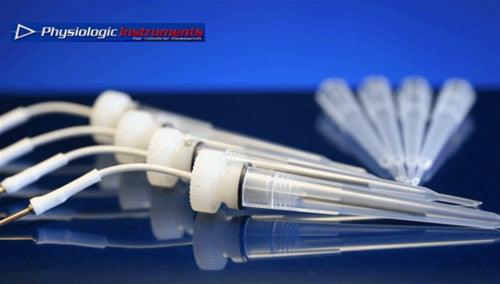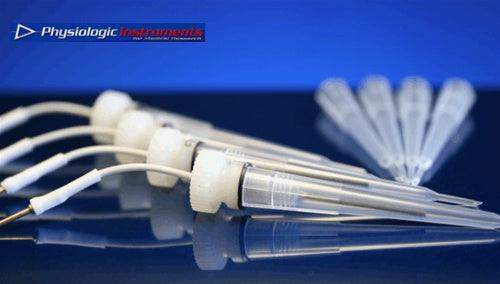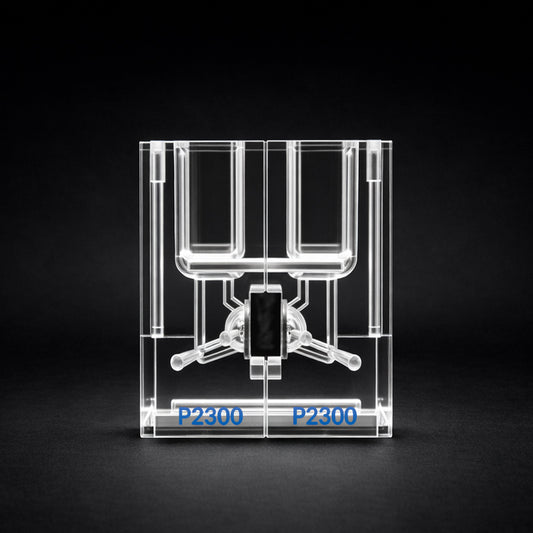EasyMount Ussing Chambers for Low-Volume - Model P2400
The Low-Volume EasyMount Ussing Chamber is specifically designed for researchers conducting studies with various animal tissues, offering a highly efficient, low-volume setup. This chamber is ideal for applications where minimizing the volume of reagents or solutions is critical, such as when using costly drug solutions or conducting FLUX measurements. Its innovative design provides precise control over experimental conditions, making it a valuable tool for physiological and pharmacological studies that require small sample volumes and high accuracy.
A standout feature of this low volume Ussing Chamber is its compatibility with a series of custom-designed EasyMount Ussing Chamber Sliders inserts, specifically tailored for different tissue types and study needs. These sliders streamline the process of mounting tissues, ensuring a secure and precise fit for reliable results. Researchers can easily select from a variety of sliders to suit specific tissue requirements, enhancing flexibility and adaptability in the lab. This modular approach allows the low-volume Ussing Chamber to be used across a wide range of studies, from basic research to specialized assays.
With a usable half-chamber volume range of 1.0 - 5.0 ml, the P2400 is optimized for experiments that require low reagent volumes, thereby reducing costs and waste. Each ussing chamber is sold in pairs, allowing researchers to set up simultaneous experiments or have a backup readily available. Its durable construction and user-friendly design make it a practical choice for high-quality, reproducible research. Overall, the P2400 Low-Volume EasyMount Ussing Chamber is an essential instrument for laboratories focused on maximizing efficiency and precision in tissue studies.
Key Features
-
Low-Volume Design: The chamber is specifically designed to minimize the volume of solutions used, allowing researchers to conserve valuable reagents.
-
Precision Control: The innovative design provides researchers with the ability to maintain strict control over experimental conditions, ensuring high accuracy in results.
-
Versatile Applications: Suitable for a range of physiological and pharmacological studies, the P2400 is adaptable for various animal tissues, making it a versatile tool in the laboratory.
Benefits for Researchers
-
Cost Efficiency: By reducing the volume of reagents needed, the P2400 helps researchers save on costs, particularly when working with expensive drug solutions.
-
Enhanced Accuracy: The precise control offered by the chamber allows for more reliable and reproducible results, which is critical in scientific research.
-
Ease of Use: The EasyMount feature simplifies the setup process, enabling researchers to focus more on their experiments rather than on complicated apparatus configurations.
The EasyMount Ussing Chamber stands out as a vital instrument for researchers engaged in physiological and pharmacological studies. Its low-volume capabilities, combined with precise control over experimental conditions, make it an indispensable tool for those working with animal tissues. By investing in the low volume ussing chamber, researchers can enhance their experimental accuracy while also managing costs effectively.
Care and Feeding Instructions - P2400 EasyMount Ussing Chambers
The EasyMount chambers have been machined from high quality acrylic resin. While acrylic is known to be very tough – one might even say “bullet proof” – it is not indestructible and does require some precautions.
The general physical characteristics of acrylics are: Transparency - In colorless form acrylic plastic is as transparent as the finest optical glass. Its total white light transmittance is 92%, the highest transmittance physically possible of any material. Breakage Resistance - Acrylic sheet has from 6 to 17 times greater impact resistance than ordinary glass. It does chip, however, and when dropped onto a hard surface it is likely that the edges will be damaged. Also, because the part has been subjected to stresses during machining, it is possible that a sudden impact will cause the chamber to crack.
Chemical Resistance - Acrylic plastic has excellent resistance to most chemicals, including solutions of inorganic alkalis and acids such as ammonia and sulfuric acid, and aliphatic hydrocarbons such as hexane, octane and VM&P naphtha.
Acrylic is attacked by the following chemicals:
1. Ethyl and methyl alcohol.
2. Chlorinated hydrocarbons such as methylene chloride, a solvent cement widely used, and carbon tetrachloride.
3. Aromatic solvents such as turpentine, benzene, and toluene.
4. Gasoline
5. Organic acids such as acetic acid, phenols, and Lysol.
6. Lacquer thinners and other esters, ketones, and ethers.
The chambers have been annealed after machining to relieve stress in the material and to increase the resistance to attack by these chemicals. They are not, however, impervious and exposure to some of these above may cause the appearance of minute cracks or crazing throughout the material. We recommend that you avoid exposing the chambers to these solvents.
Dimensional Stability - Acrylic sheet is notable for its freedom from shrinking and deterioration through long periods of use.
Combustibility - Acrylic sheet is a combustible thermoplastic and should be treated as an ordinary combustible material such as wood. The self-ignition temperature (spontaneous combustion) of acrylic is between 850 degree F and 869 degree F. The temperature at which the material will ignite in the presence of a flame is between 550 degree F and 570 degree F. Bottom line - the chambers may be damaged by fire or drying them in a hot oven.
Heat Resistance - The maximum "continuous service temperature" of acrylic is about 180 degrees F. Procedures that may increase the temperature above this should be avoided. While the material can withstand higher temperatures for very short periods of time, it will soften and lose its form or shape if subjected to these higher temperatures for any period of time. Procedures to avoid would be placing the chambers in a microwave (the material contains enough moisture to heat considerably), drying the chambers in an oven, and sonicating at high power as this may cause local heating above the melting point. While acrylics respond to heat, they are not affected by cold, and will not become cracked or brittle in cold.
Electrical Properties – The surface resistivity of acrylics is higher than that of most other materials making it a good material for isolating the two sides of an epithelium. U-Factor - heat transfer through acrylic is approximately 20% less than through equivalent thickness of glass.
Cleaning the Chambers: The chambers should be washed in warm water using a mild detergent and then rinsed rigorously with deionized water. We recommend air-drying while placed inverted on a rack or toweling. WARNING: Sonicating the chambers at high energy levels and/or for long times can raise internal temperatures in the acrylic sufficiently to cause melting, deformation of channels, and cracking.
Cleaning by sonication is, therefore, not recommended.
Note: on stainless steel guide pins: Some of the stainless steel guide pins were made from type 416 stainless. Unfortunately, this type of stainless is less rust resistant than others and we have recently experienced problems with them “rusting” at their tips. Chambers shipped after Oct, 2001 all use type 18-8 stainless, which is more rust resistant and should not present any rust issues. Please contact us if you experience rust problems with any of our chambers.
Although stainless is more resistant to corrosion than mild steel, the name of the metal is a bit misleading. The basic corrosion resistance of stainless steel occurs because of its ability to form a protective coating on the metal surface due to the combining of oxygen with the chrome in the stainless to form chrome oxide (commonly called ceramic). This coating is a passive film that prevents oxidation of the iron in the steel (rusting). Unfortunately, this film is subject to attack by halogen salts, and chlorides are especially good at penetrating this passive film. Once broken, corrosive attack or “rusting” can occur. Since most physiological saline solutions contain chloride the guide pins are frequently exposed to chloride salts. Also, sterilizing the chamber with Clorox bleach will expose the pins to high concentrations of halide. We suggest routinely protecting the pins as follows. Firstly, remove any rust spots from the pins using a brass, silver, or chrome cleaner. Then, after normal use, rinse the ins with distilled water and dry them by wiping with a cloth containing a little silicone car wax. This will protect them and make them slide easily into the chamber.


















